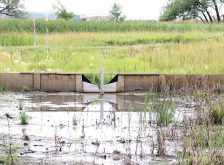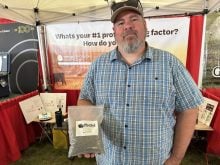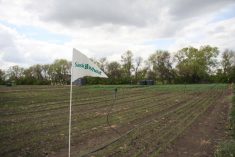Phosphorus has always been an essential nutrient in crop production. Maintaining the right P balance — ensuring there’s enough of it to sufficiently feed crops, but not too much of it so it runs off fields or seeps away to contaminate water bodies — is an ongoing challenge for Prairie farmers.
Manitoba crop nutrition expert Don Flaten says while progress has been made on reducing excess P, it has been tough slogging on the other side of the ledger.
Read Also

Cancer agency reclassifies another herbicide ‘probably carcinogenic’
The WHO’s cancer research agency has now put atrazine, a herbicide well known to corn growers, in the same potential-hazard category where the agency put glyphosate.
“Crops need phosphorus to grow and there are no significant atmospheric sources, so we have a challenge on our farms to make sure that we maintain our phosphorus supplies in the soil when that crop is harvested,” says Flaten, who was among the presenters at the CropConnect 2024 conference in Winnipeg in February.
“If we take a look at the production of canola, for example, 50 bushels of canola is going to require about 45 pounds of phosphate per acre to grow and 39 pounds of that will be removed when the crop is harvested.”
Flaten recently retired as a professor in nutrient management and crop nutrition in the Soil Science department at the University of Manitoba in Winnipeg.
At the CropConnect conference and in a subsequent interview with Grainews, Flaten talked about how soil phosphorus deficits continue to rise in many areas across the Prairies. Importantly for farmers, he also offered some solutions for addressing P imbalances.
Flaten referred to a study by the International Plant Nutrition Institute that indicated 81 per cent of Saskatchewan fields and 64 per cent of Manitoba fields in 2015 had soil test P concentrations below the critical level for crop production.
“It is a little bit variable, but the majority of our soils are still testing deficient in phosphorus,” he says.
According to Flaten, a combination of higher yields and greater crop diversification has contributed to phosphorus deficits in many fields in the eastern Prairies.
“We have more crops that are sensitive to excess P in the seed row than back in the day when wheat was king. The cereals are quite tolerant to high rates of P in the seed row, but crops like canola and soybeans are not. So as the acreage of those crops has increased, we see more and more phosphorus imbalance within certain crop years,” says Flaten.
“If a farmer is growing canola or soybeans, that’s often a year when the phosphorus application rates are lower than the phosphorus removal rates. There will be a P deficit for that year, which doesn’t always get counterbalanced with more P going on in other years.”
Flaten says improved genetics and agronomics for crops such as wheat, canola and soybeans have improved yields dramatically — which means more phosphorus is drawn from the soil.
“We’ve seen pretty much a doubling of crop yields … over the last 40 years or so,” he says. “The amount of phosphorus that can be conveniently applied, say by placing it in the seed row at time of planting, is still pretty modest with some of our crops, especially P-sensitive crops like canola. This means there are some extra challenges to maintaining the P balance.”
Flaten says another difficulty in restoring P levels in phosphorus-deficient soils is that it generally isn’t a quick fix — and there may be economic disadvantages to doing so.
“If a farmer has rented land or is nearing retirement, for example, there’s not necessarily as much financial incentive in those situations for putting on phosphorus at high rates that match crop removal,” says Flaten.
“That’s a challenge that we struggle with, because the short-term economics don’t necessarily provide an incentive to maintain your fertility, especially on rented land.”
Flaten explains a short-term P approach that acts to maximize yields and optimize fertilizer investment for farmers will drive down the fertility of farmland over time. He says producers can help keep that from happening by taking a longer view and following 4R nutrient stewardship practices to make their phosphorus management more sustainable.
Sustainable practices
Flaten suggests farmers start by choosing a source of phosphate fertilizer that’s affordable and enables them, over the course of a three- or four-year crop rotation, to apply P in their fields at a rate that matches crop removal.
Springtime during planting is generally the best time for applying phosphate fertilizer, he says, and it’s important to place P precisely as possible to maximize its benefits and also reduce environmental losses. That can be done either in the seed row for crops that tolerate phosphate fertilizer well, or near the seed row through applications such as side banding or mid-row banding for crops that don’t.
These steps will help ensure crops have ready access to phosphorus at a time it’s most needed, when the plants are just beginning to grow in the colder soils of early spring.
According to Flaten, farmers who don’t have access to side- or mid-row banding equipment could consider a rotational fertilization approach. This involves putting on surplus P in the cereal phase of a rotation, as a way to offset P deficits in years with pulse and oilseed crops.

Flaten suggests another way to ensure proper P levels is to apply enough manure to meet a crop’s nitrogen requirements, which should also supply enough phosphorus to match a crop’s P removal for several years.
Flaten says Prairie farmers who have a typical rotation with a variety of crops should aim for phosphorus soil levels somewhere between 10 and 20 parts per million in an Olsen P test.
Considering how much money producers spend on fertilizer every year, Flaten contends they’d be wise to soil test their fields annually. “I know some people just check their fields once in a while or just check a few fields (but) I think every field should be tested every fall.”
Flaten says this way, anomalies in P levels within and between fields can be detected and addressed, “and that’s where soil testing can really pay off.”
Phosphorus recycling
Flaten maintains there are bigger, systemic reasons for phosphorus imbalances found in Prairie cropland, beyond farmers’ fertility practices. One is the way grain is marketed.
“I think we’re gradually evolving to a more sustainable approach to the phosphorus management issue, but it’s still in many ways a tough situation with an export-oriented economy,” he says.
“For our grains in particular, we are exporting a lot of phosphorus from the Prairie provinces into international markets. And that phosphorus doesn’t come back.”
Flaten notes utilizing human waste as a way to recycle phosphorus in areas where food is both produced and consumed may be an efficient solution — but our export economy complicates things.
“Feeding humans around the world comes with a consequence of creating a very challenging system for recycling nutrients,” he says.

Flaten points to struvite, a granular fertilizer made from urban wastewater or liquid manure, as a recent innovation that’s addressing this problem.
Struvite is an ammonium-magnesium phosphate mineral, which forms naturally in kidneys as kidney stones or wherever wastewater or liquid manure is stored or processed.
Crystal Green is struvite product available to Prairie farmers. Flaten says it has been shown to be a safe, effective alternative to conventional phosphate fertilizers, which are largely derived from mined rock.
Flaten acknowledges the higher cost for struvite products could be a sticking point for farmers. But he stresses there’s a price to be paid for over-dependence on geological reserves of phosphorus, which are limited and non-renewable and can be subject to wide fluctuations in availability and price.
There’s also growing competition on the demand side for phosphate — for electric car production and other uses that have nothing to do with food production — which doesn’t sit well with Flaten.
“For me, as an agricultural scientist, it just boggles my mind why people think that would be a good idea. Future generations will probably look back at us and wonder what the heck we were thinking,” he says.
“The short-term economics don’t always favour conservation. Recycling of P is a major public good, but that’s a public good for the benefit of future generations. And that’s something that we’re not all that great at, figuring out a mechanism to make the world a better place for future generations.”
















